Blogging is not a must for every Shopify store, however, instead of asking “Do I need a blog for my Shopify store, the real question is “why not?”. It’s low-cost compared to paid marketing channels, while being capable of driving generous traffic, establishing brand awareness and converting customers. Thinking about building a blog for your Shopify store? These successful Shopify blog examples will help.
1. Best Shopify blog examples with influencers interview
Asking someone who has influence over your customer audiences to speak for your brand is not new. In fact, it is a common content marketing strategy for Facebook & Instagram
As popular as the marketing strategy is, not every brand can nail it. The followings are two great examples of how to feature influencer marketing in a way that drives traffic and polishes your brand images.
Example 1.1 Great Jones Good
Traffic: 16.2k/ month

About Great Jones Good:
Great Jones sells cookware and bakeware with a motto to “make the kitchen your happy place”. Besides quality, their cookware stands out with vivid and cheerful colors, which definitely raise a sense of happiness.
About Great Jones’ blog
Great Jones blog – the Digest has a simple photo grid layout toned in warm and bold colors. They have only two main categories: Recipes and Great Ones. The former is, of course, to share tasty cooking recipes. The latter features popular chefs and influencers cooking and sharing why they cook.
Choosing the right micro-influencers
When thinking about cooperating with influencers, many businesses tend to think that those with large followers will be better, but that’s not always the case.
Forbes suggests that those with smaller fanbases can have a stronger relationship built on expertise and trust with their followers. Therefore, working with mirco-influencers (those with less than 50,000 followers) serves better-niched audiences while greatly saving budgets.
When you look at who Great Jones decided to interview and work with, you can see lots of them are mirco-influencers ranging from chefs, cookbook writers to TV series actresses, entrepreneurs and even trending Tik Tokers.
Despite their varied professions and backgrounds, they are all related to cooking at some point. For example, in one article, they interview a hot Tik Toker whose videos of their mother’s cooking go viral. In another blog post, the Great Jones shares thoughts of a vegan blogger.
Great storytelling
In a time when we are flushed with short-form Instagram reels and memes, there’s no way to persuade your visitors to sit down and read a 1000-word blog, if it’s not worth it. What Great Jones does is dig in-depth into the personal stories of their guests to bring out something meaningful, relatable, and enjoyable.
From embracing the mutual time between mother and daughter, to how cooking can help with building a community, to celebrating cheeses, each article brings something new to the table that their target audience would love to read on their sofa bed while sipping a cup of tea.
Example 1.2: GymShark
Traffic: 54k/ month
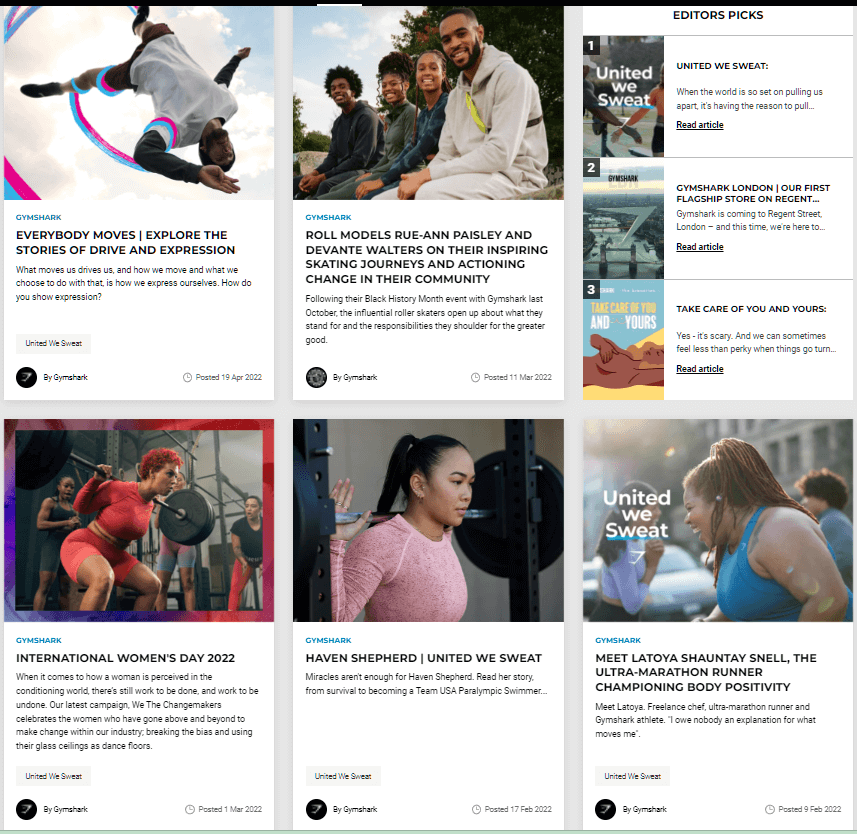
About GymShark
GymShark sells activewear and accessories for runners, gymers, boxers, etc for them to achieve their best workout performance, thus, be the best version of themselves.
About GymShark’s blog – the Central
Their blogs cover a wide range of categories to help users work out the right way, provide nutrition advice as well as promote their new collection. Significantly, they have inspiring stores where successful athletes share their journey and their passions with the community.
Right influencers, right content, right timing
Same as Great Jones, GymShark uses the great recipe for blog influencer marketing, which is right guests & right content.
For a brand like GymShark, they provide daily inspirational insights that gymers and athletes would love to engage with on a daily basis. Featuring popular bodybuilders, and athletes, the blog shares their up-and-downs, how they challenge their body limits, and how they get support from their families.
Moreover, their blog team gets creative to provide captivating content following current trends and events. For example, their Black History Month 2022 interviewed three badass black people who have significantly helped with the black community’s wellness via sports.
Another great example is their Black Friday Face-off challenge, where they invite atheletes to combat head-to-head in a variety of challenges from push-up to bench presses. Who’s gonna love watching popular athletes facing each other in challenges for power, endurability, and resistance? We bet all of their customers do. This is an amazing way to create more buzz around their Black Friday sales.
Key takeaway
- Choose the right influencers for your niche
- Explore in-depth personal stories and experiences to create meaningful articles
- Catch up with trends and events to make the interview even more intriguing to read.
2. Best Shopify blog examples with stunning product presentation
When thinking about blogs or journals, many of us would think about (lots of) texts, heading, and paragraphs. However, it does not have to be that way. The Shopify examples of Taylor Stitches and Grovemade show how to make a blog a great place to promote products using amazing visual storytelling.
Example 2.1: Taylor Stitches
About Taylor Stitches
Taylor Stitches sell men’s clothes, shoes, and accessories with a strong focus on sustainability and durability.
About Taylor Stitches’ blog – the Dispatch
The Dispatch embraces a minimalist approach using lots of white spaces and large photos. It has only two categories featuring interviews and their product collections.
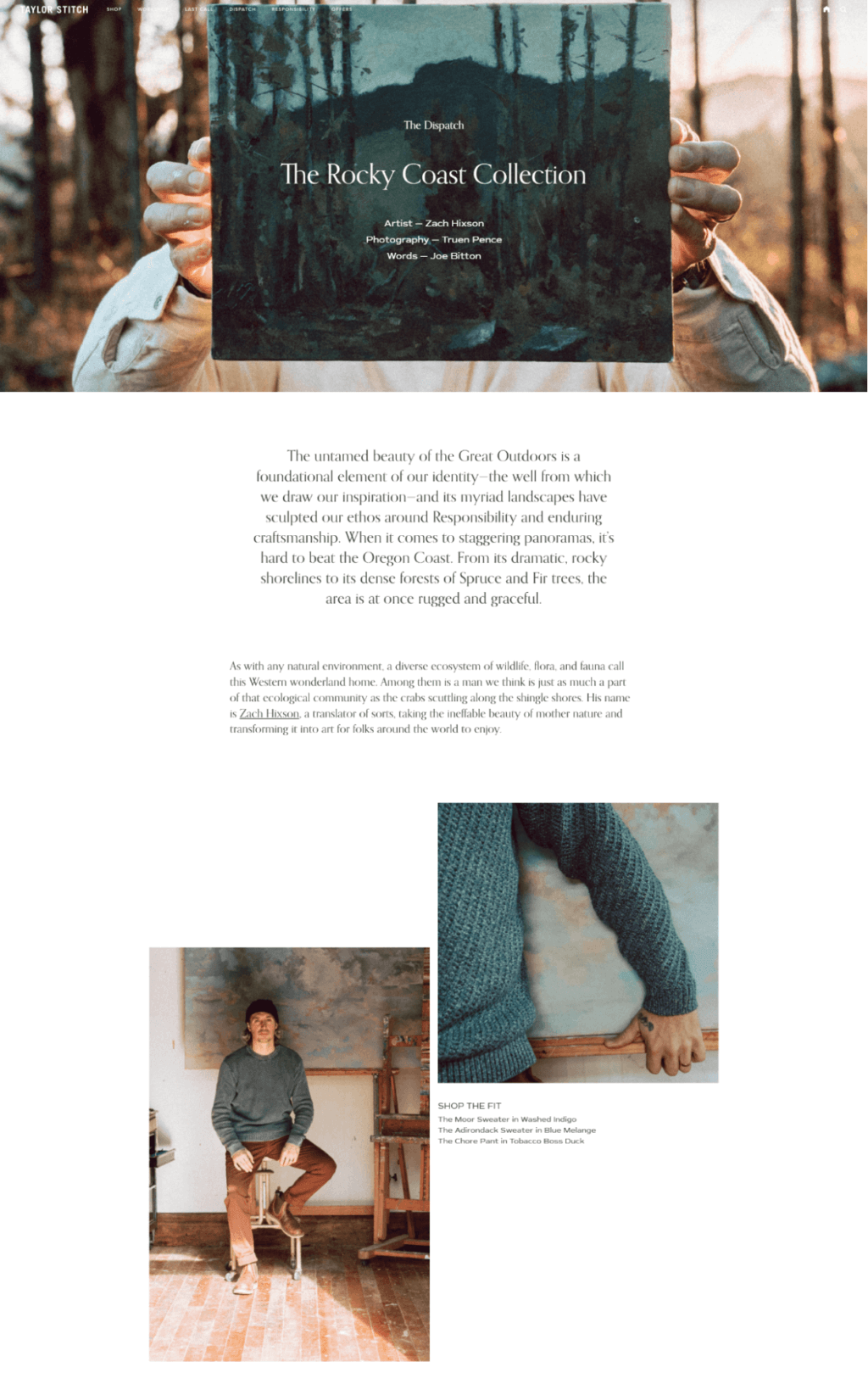
Showing off product in a flattering way
Whenever a fashion brand launches a new collection, it’s common for them to have a great photo album of that collection. For Taylor Stitches, they take advantage of the blogging function and Shopify’s easy-to-use page builder to create stunning presentations for this purpose.
While of course, these pages may not drive lots of traffic from search engines, they can serve as landing pages for users to visit from social media and email newsletters. Once captivated by the visuals, Taylor Stitches’ customers will be very likely to explore more products and buy.
Being short and easy to read
Unlike normal blogs where people read to get more information and insights, the Dispatches’ product promotional blogs comprise only short paragraphs with big texts. By doing it this way, they hit many critical points:
- Not scare people away from reading many words
- Put a focus on photos and text content that matters
- Quickly guide users to shop for their collections without creating any distractions.
Example 2.2: Grovemade
Traffic: 93.9k

About Groovemade
Groovemade sells refined home office supplements from desk shelves, mouse paths to stationary mainly made from woods and leather. Being a successful business in their niche, they have more than 50,000 subscribers.
About Groovemade’s Journal
Besides telling customers stories, the blogging space of Groovemade focuses on their products, their special features, how they are designed, crafted, and which materials they use.
A Full 360 view of products
A Groovemade mouse pad costs around $170 and their pen costs around $90. Their high prices come from their use of luxury materials, advanced leather-tanning and corking techniques as well as well-researched designs.
For those who are willing to spend that much money for a home office item ( either for themselves or to use it as a gift), Groovemade makes sure they understand their product values with their blog.
Their “Design stories” category shows every step the team has made to redesign a product from problem recognition to testing different variations.
Their “Behind the scene” category shows how a product is made, why it is made that way by using a combination of well-recorded videos and visually appealing photos.
Their “Material Focus” explains the leather, the wood they use, its characteristics, its usage, etc.
Playing with photos and videos
To provide the most enjoyable reading experience, Groovemade has used various mediums from photos, Gif, to video and sketches. There are many different photo layouts, too, from full-width banners, single photos to 4-photo grids.
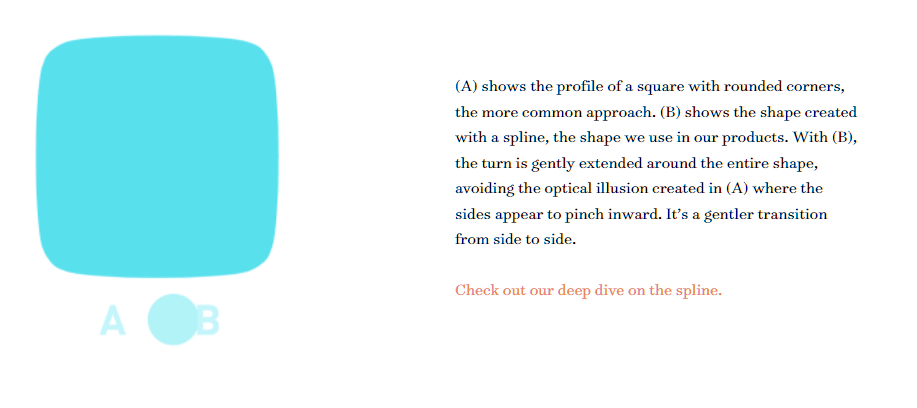
Using gifs to simplify a difficult concept

Using a three-photo column to organize photos neatly without taking too much space.

Using full-width photos to highlight the products.
Key takeaway
- Use blogs to tell more stories about your products
- Create short and descriptive copy-writing
- Test different photo layouts and mediums to achieve the best results.
3. Best Shopify blog examples with unique content:
The original idea of having blogs are for creating something worth reading. While there are 600 MILLIONS blogs on the internet and your blog is competing with dozens of others for your users’ time, the best way is to be unique & valuable content. Getmaude & BeardBrand are two Shopify blog examples that succeed to do so.
Example 3.1: Getmaude
Traffic: 192.3k/ month

About Getmaude
Getmaude brands themselves as a “modern sexual wellness company”, which sells anything from candles to supplements that help make intimacy better.
About Getmaude’s blog – The Maudern
The Maudern is a dedicated journal that explores intimacy in the modern world from the view of arts, science, and relationships.
Unique, well-researched content
While the Maudern is a good learning center for visitors to educate themselves about wellness and relationship, it offers even more by publishing interesting articles exploring different topics of intimacy that we do not often think of.
For example, they explain the origin of the word “horny” or discuss America’s love affair with sex in cars from a historical point of view.
Also, they put lots of effort to make sure the information is legit by sourcing viewpoints and data from reliable studies, surveys, and publications.
In the internet world where everything can be copied and pasted easily, blogs that bring fresh ideas & stories like this can go a long way to keep visitors engaged with the brand.
Example 3.2: Beardbrand
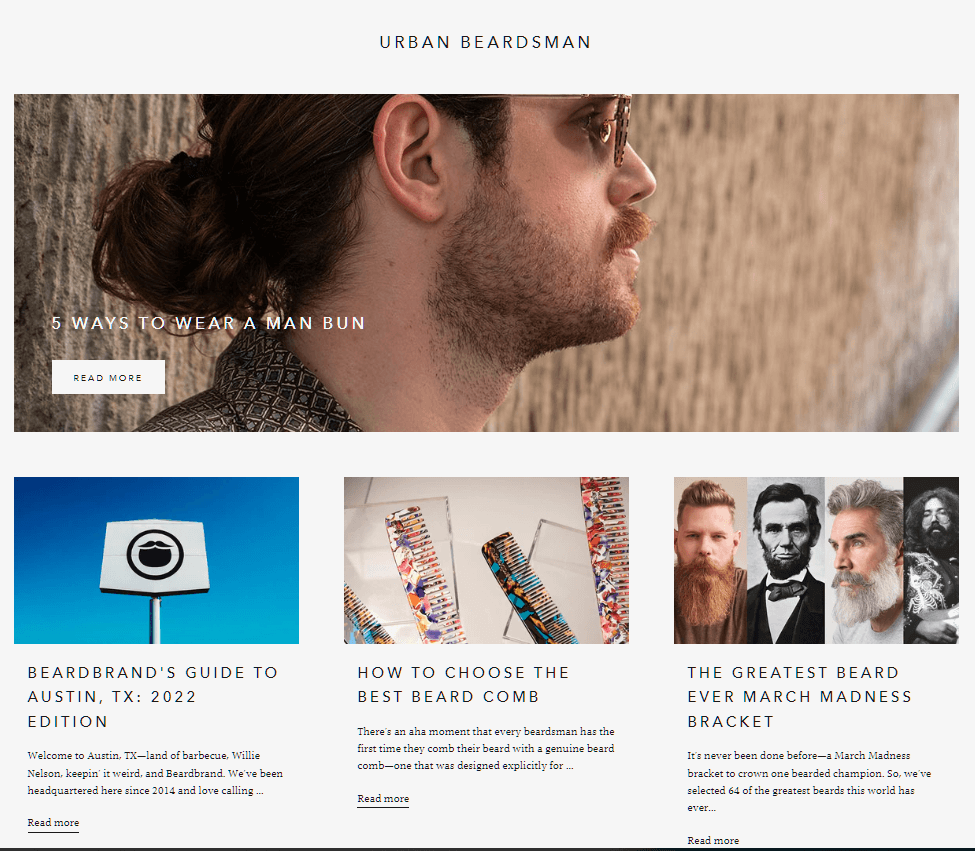
Traffic: 430k/month
About Beardbrand
Beardbrand sells beauty products for men ranging from body products to fragrances, but they put their best effort into creating refined products beards & mustaches.
The brand’s success is tightly connected with content marketing via its Youtube presence, which now has more than 1.62 million subscribers.
About Beardbrand’s blog – Urban Beardman
Using a minimalist blogging layout, the Urban Beardman covers a wide range of topics to help men have a nice beard and stay confident.
Provide in-depth information on one niche
The brand has more than 900 articles ever since they started blogging in 2014, with the vast majority of the blogs being about beards.
They cover all popular questions that men can have with beards like “The best beard style in 2022?” and “What beard oil does and how to use it?”.
But that’s not everything. They also bring up some unconventional topics that we don’t even know we need it. For example, an article gives advice on “What to do when you think your beard sucks?”, and another discusses how working out can help grow a better beard.
It’s surprising to know there are that many things ones can talk about beard, and their team has made great efforts to give readers valuable content in-depth.
As a result, people come back to the brand not just because they want to buy something, but also because they need some inspiration to have a nicer beard, or to seek tips & advice to help them solve beard-specific problems.
Newsletter

Beardbrand includes a newsletter form, which tempted users to fill in their emails to receive more updates.
This is easy especially when the users have already had some built-up trust and interest in their shared content.
Once successfully grown a list of email subscribers, Beardbrand can send more article suggestions to increase traffic from returned visitors, promote their products, and give away deals to boost conversion.
Key takeaway
- Bring something new to the blogging table
- Give thorough information about your niches
- Include an opt-in form for newsletter subscription
4. Best Shopify blog examples with good SEO strategy
For those who write blogs with the ultimate focus on getting more traffic and conversions, it’s impossible to ignore SEO (search engine optimization).
SEO is a set of practices to get your page found on search engine result pages when your users look up some information. Great SEO performances are the fruit of a keyword-driven content strategy, technical optimization, and a user-friendly blogging experience.
Here are some examples of SEO – successful Shopify blogs
Example 4.1: Bulletproof
Traffic: 375k/month
About Bulletproof
Bulletproof sells vitamins and supplements that are clean, artificial fillers-free to improve health & wellness.
About Bulletproof’s blog
Bullet features a rich collection of articles ranging from recipes to wellness and lifestyle tips for visitors to learn how to stay healthy in the modern-day.
Contents focused on keyword searches
Traffic: 375k/month
Instead of brainstorming blog ideas and expecting that someone might need them, Bulletproof takes advantage of keyword research tools. The tools help them understand what their customers are looking for based on what they type in the search bar. Then, they write articles that answer those queries to bring traffic to the site.
Bulletproof’s “Shirataki Noodles for Keto: Nutrition & Benefits” article ranks no. 6 for the keyword “Shirataki Noodles”, which has about 157,000 searches a month.
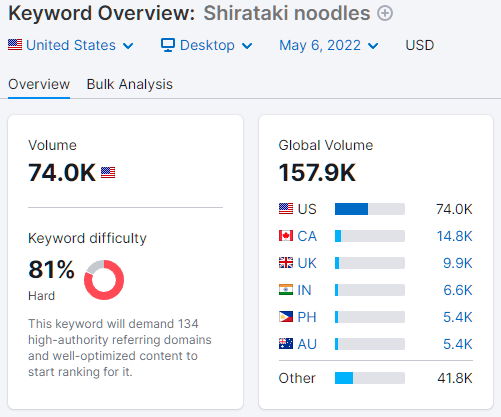
According to Semrush, 1.97% of that search traffic visits their site, which means they manage to generate over 3000 free monthly traffic with one article only.
Content for quick reading
The average time people spend on a website page is 54s. This means even though an article takes 10 minutes to read, most visitors will only scan and skim to find important information.
Every article published by the Bulletproof follows a solid structure for their users’ pleasant and effective reading experience.

The “Article at a glance” captures the main takeaway of the whole articles

The Table of contents helps readers quickly understand the blog’s structure and navigate to their desired section.
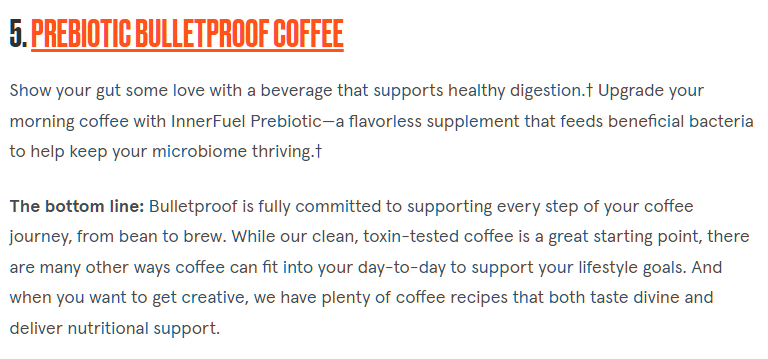
Using heading to make it simple to spot important information and using short paragraphs for easier reading.
Sourcing information and proving reliability
For a brand that talks about nutrition and diets like Bulletproof, the accuracy of their provided information stay among the top priority (if not the first). People will appreciate the knowledge that is backed by scientific research rather than personal experience.
For that reason, Bulletproof writers often take references from lots of trusted websites, many of which are from the government’s official research.

Also, their articles are carefully reviewed by doctors for scientific accuracy, and they make sure their visitors know their efforts.

Example 4.2: Luxy hair
Traffic: 362.4k/month
About Luxy hair
Luxy hair sells all hair essential goods from hair accessories, and hair care products to hair extensions.
About Luxy Hair’s blog
Luxy Hair provides useful and actionable hair care tips, which they get ideas from keyword research. The website achieves a great ranking for several search queries regarding hair styling. For example, they rank on the first result page of the search query “french braid”, which has more 65k searches per month.

Besides the hair guide, the brand also publishes articles sharing trending fashion looks, beauty and lifestyle tips, as well as their insider’s stories for their women readers.
Link to other pages on the website
Luxy Hair takes a common SEO practice called “internal link”, which means linking one blog to other articles on their site.

For example, in one article about “5 reasons to embrace gray hair”, they refer to another article that talks about how grey hair is no longer a taboo anymore.
Internal links can help search engines like Google understand website content better, which improves SEO performances and drive more traffic. In fact, it’s suggested to have as many internal links as possible. For instance, we notice about 20 internal links in a 2000-word article page of Luxy Hair.
However, it’s worth noting that they don’t spread internal links randomly just to achieve a certain number. Too many links can create a messy page for website visitors to read, as well as they distract users from finding the information they need.
Instead, Luxy Hair only includes an internal link when the linked article is relevant to what they are writing about.
For instance, when they talk about Australian women’s secrets of protecting their hair from sun damage, they introduce another article that dives deeper into hair protection while swimming.
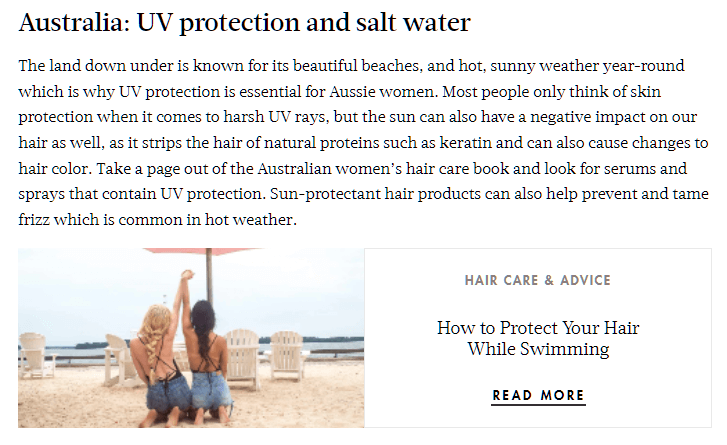
By only providing relevant internal links, Luxy Hair ensures that readers are more interested to click the links. Thus, the visitors can spend more time on the site, become more acquainted with the brand, and buy.
Promote products within articles
While the ultimate goal of SEO is to convert readers into customers, sometimes it can be tempting for businesses to over-promote their products in the blogging sphere, which ends up causing poor user experience.
Luxy hair manages to decently merchandise its products without being too pushy. The strategy they use is similar to their internal-linking strategy: promote products relevant to the written content.
This includes manually picking the suitable items for each article for the Shop The Look section at the page end.
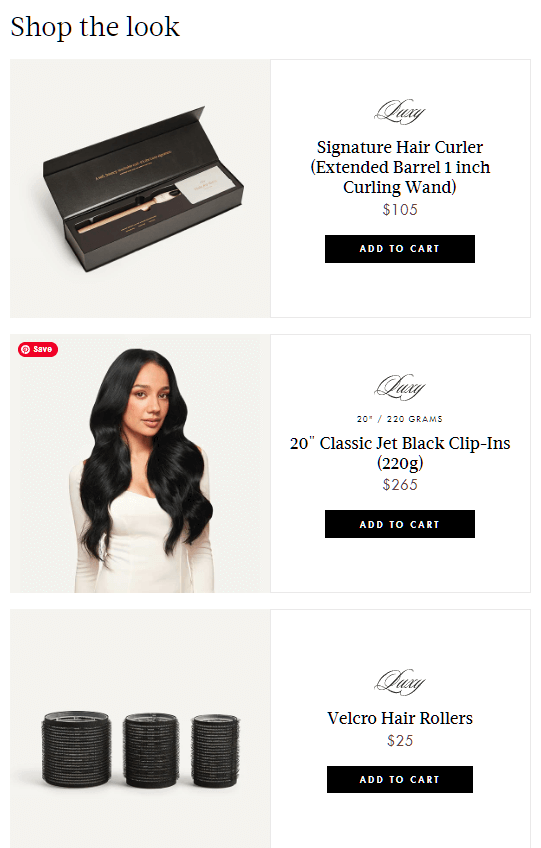
Also, they subtly include internal links to promote their items in their article text as well.

For instance, in a blog instructing people to pull off “wet styling”, they mention their hair extensions as a solution to make the hair look thicker.
Key takeaway
- Research keywords to learn what your customers care about and write articles about it.
- Structure your blog so that it’s clear and easy to read
- Use internal links to improve SEO and user experience
- Subtly introduce products relevant to the content of the articles
5. Best Shopify blog examples with funny content
Everyone enjoys a good laugh, and an entertaining blog can keep readers coming back for an enjoyable time, as well as create more in-depth brand awareness in their audience’s mind.
On the other hand, humor content is probably the most difficult one to get right. It’s important not to try too hard to be funny, because it will be off-putting instead. For your inspiration, we explore Talking Crap & Tushy as great Shopify blog examples for humorous content.
Example 5.1 & 5.2: Who Gives A Craft & Tushy
Traffic:
- Who Gives A Craft: 56.8k traffic/month
- Tushy: 155.8k traffic/month
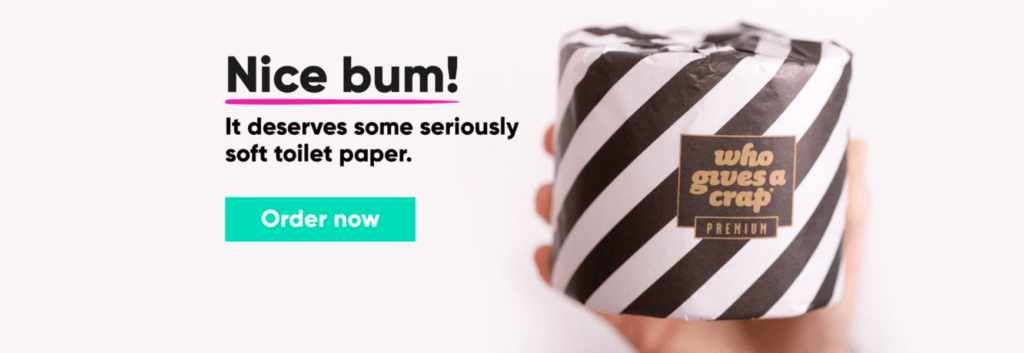

About the two brands
Both Talking Crap & Tushy sell toilet paper, while Tushy also offers other washroom accessories such as toilet brush or bidet attachment. The two brands also take sustainable living into their consideration.
About the two brands’ blogs:
Both blogs embrace simple layouts using playful colors. For Talking Crap, their topics focus on toilet paper & eco-friendly tips. Meanwhile, Tushy covers more categories from butt health and gut health to sex & wellness.
Pun master
Both two businesses wittily use puns related to poop and butt to create a funny & light-hearted writing tone.
For example, Tushy’s blog is named “Cool-sh*t-to-read on the toilet”. In one article, they use the word “But(t)” instead of “But”, “poo-cise” instead of “precise”.

Similarly, Who gives a crap once used “Revo-loo-tion” instead of “revolution”.
It can be embarrassing to talk about poop health & everything related to it. These kinds of topics, if not done right, can end up being too scientific to understand or too unpleasant to read.
Using puns adds a funny twist to the writing piece, which makes an uncomfortable topic accessible and enjoyable for everyone to explore.
Also, a meme-master
For many posts of Who Gives A Craps, we notice that they use memes, specifically animal memes.

People on the internet love memes, and creating memes can be a good way if a brand is trying to create funny and entertaining content for its users. It has some great merits that are hard to ignore:
- It is easy to make with literally no designing skills needed.
- It’s not difficult to think of ideas for memes if you already enjoy them on the internet. Simply scrolling 9gag or Facebook can give you a ton of ideas for your photos.
- Using photos and texts from popular & trending memes can help you stay relevant and funny to the majority of internet users.
Key takeaway
- Use puns and memes to create some humor in your content
The bottom line
When a newly-found Shopify business thinks of starting a blog, there are often lots of doubts in their mind. “Will it be successful and drive me a great deal of traffic or is it gonna be a waste of time?”
We hope that these Shopify blog examples can ensure you that it’s possible to succeed, but it may take lots of effort and patience.
Most blogs do not attract tons of visitors through days, but rather through months and years. Plus, their blog team needs to work hard to research keywords, invent content, do SEO tasks, find influencers, etc.
However, these examples also show that there is no ultimate recipe for blogging. Some can implement a strict SEO strategy, while others only use blogs to promote their products and tell brand stories, while others do something in between.
What matters most is understanding your business & your audience. Then you can test & come up with the best strategy for your business, without spending too much time & money.



